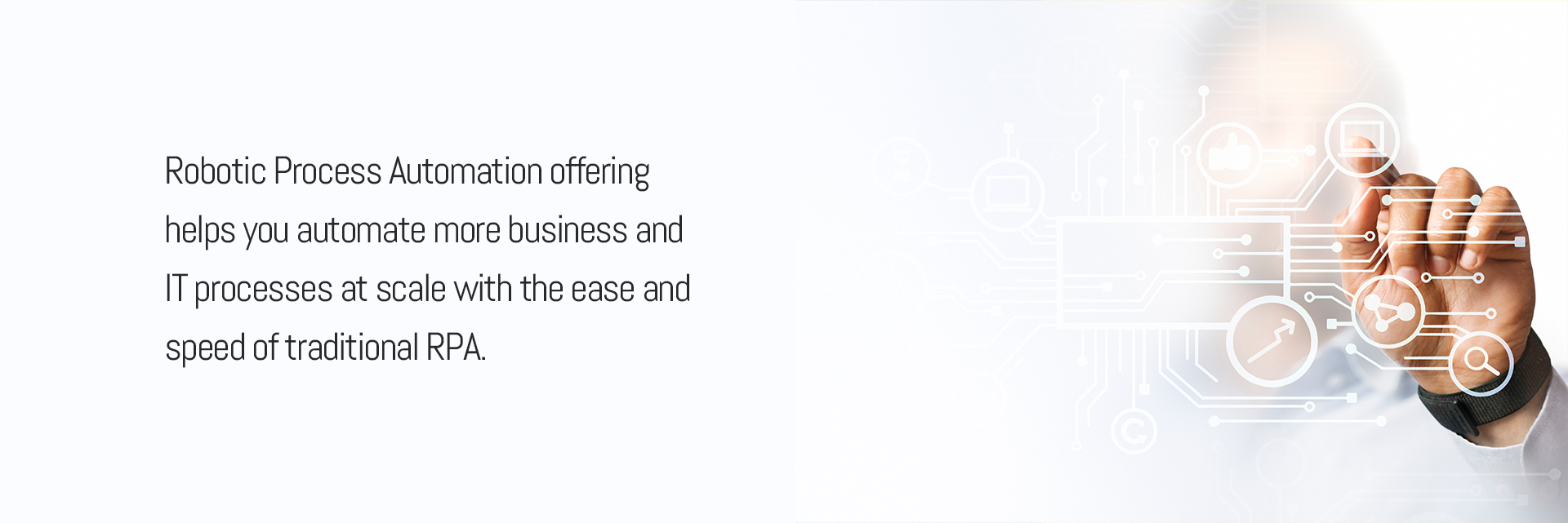Introduction
According to research by Gartner, digital transformation is the process of exploiting digital technologies and supporting capabilities to create a robust new business model
Organisations often find it a challenge to automate the various businesses processes to enhance operational processes, customer relationships, sales, and service. RPA is a technology that supports Digital Transformation in improving business outcomes.
Robotic Process Automation helps you automate more business and IT processes at scale with ease and speed. Software robots, or bots, can act on AI insights to complete tasks with no lag time and enable you to achieve digital transformation.
RPA is one of the technologies that is best able to help all functions within organisations to evolve with digital transformation. Given RPA’s capabilities, organisations can tackle extensive operational challenges, such as executing the large amounts of back-office activities.
Course Duration : 6-8 weeks @ 5 hours/week
Skills
You’ll Gain
➤ Introduction to Robotic Process Automation
➤ Design considerations for RPA solution
➤ Capturing and interpreting existing application
➤ Advantages of Robotic Process Automation
➤ Windows Desktop RPA software UiPath
➤ Automation of back office repetitive processes
➤ Using variables and arguments for data manipulation
➤ Text and image Automation with RPA
➤ Workflow automation, debugging and exception handling

Is this
course for you?
Software Engineers, Software Testing and IT Professionals can take this online RPA training. If you want to make the best of the boom in RPA market, then this online training is for you.
Course Pre-requisites
None (no bachelor’s degree or international equivalent is required)
Curriculum
M1. Introduction to RPA
1.1The important methods of Robotic Process Automation
1.2 The architecture pattern of RPA
1.3 Developing the RPA process
1.4 The various tools used in RPA
1.5 The different types of bots
1.6 Selection criteria
1.7 The lifecycle of RPA
1.8 Handling data solution pattern
M2. UiPath tool for RPA
2.1 Introduction to UiPath tool for Robotic Process Automation
2.2 Understanding the workflow activities and workflow files in UiPath
2.3 The different user interface of UiPath
2.4 Automation activity package
2.5 The various projects in UiPath
M3. Important components of UiPath
3.1 Introduction to UiPath Studio
3.2 UiPath Robot
3.3 UiPath Orchestrator
3.4 Working with variables
3.5 Managing control flow
3.6 Excel automation
3.7 Desktop, Web & GUI automation with UiPath
M4. UI automation
4.1 The process to automate the user interface with UiPath
4.2 Automated tasks configuration
4.3 Various variables
4.4 Output viewing
4.5 Arguments
4.6 Importing the packages
M5. Recording with UiPath
5.1 Detailed learning of the recording
5.2 Scraping methods
5.3 User events
5.4 Recording of sequence of events fit for automation
5.5 Extracting data from browser
M6. Programming activities using data table
6.1 Understand programming activities using Data Table
6.2 Learn Data Table Structure
6.3 Comprehend Searching Method
6.4 Data Table Activities
6.5 Create an environment and associate the workflow
6.6 Understand Creation of Collection
6.7 Know about Sequence and Flowchart
6.8 Assimilate Send Get and Read Email Message
M7. Workflow and Citrix manipulation
7.1 Introduction to invoking a workflow in UiPath
7.2 Manipulating data using UiPath
7.3 Citrix automation for accessing virtual applications
7.4 Virtual environment automation
7.5 PDF automation
7.6 Advanced Citrix automation.
M8. UiPath coding and debugging
8.1 Introduction to programming in UiPath
8.2 The various projects related to organization
8.3 Debugging and handling of exceptions
8.4 Detailed understanding of programming activity
8.5 Handling of errors
M9. Screen scraping with UiPath
9.1 Importance of screen scraping with UiPath
9.2 Various aspects of screen scraping like taking screenshot, activating, highlighting & selecting item, getting text, setting clip region, loading image and more
M10. Automate and orchestrate the task
10.1 Learn to automate the process of Reading Email Message
10.2 Downloading Email Attachment
10.3 Sequence and Flow Chart
10.4 Reusable Component of Email
M11. Create a scalable queue management system
11.1 Understand what Queue is
11.2 Learn about Queue Management System
11.3 Comprehend Data Scraping
11.4 Know about Insert in Queue
M12. RE framework
12.1 Working with RE-Framework
12.2 Introduction to RE Framework
12.3 Using State Machine Layout
12.4 Different States of the State Machine
12.5 Workflows of the Framework
12.6 Global variables and default variables of main workflow
Course Brochure
Request for DEMO
